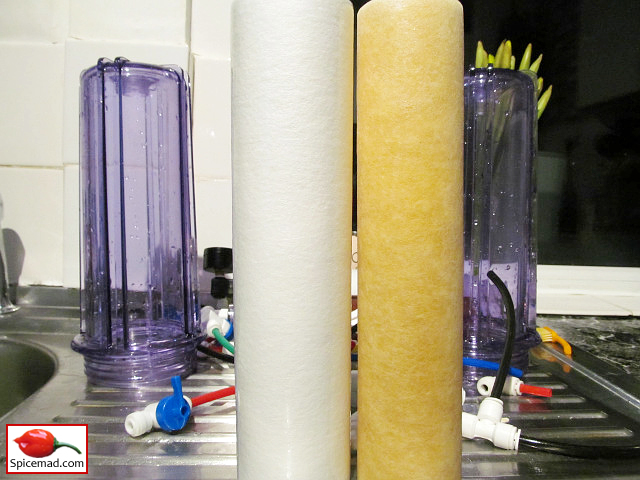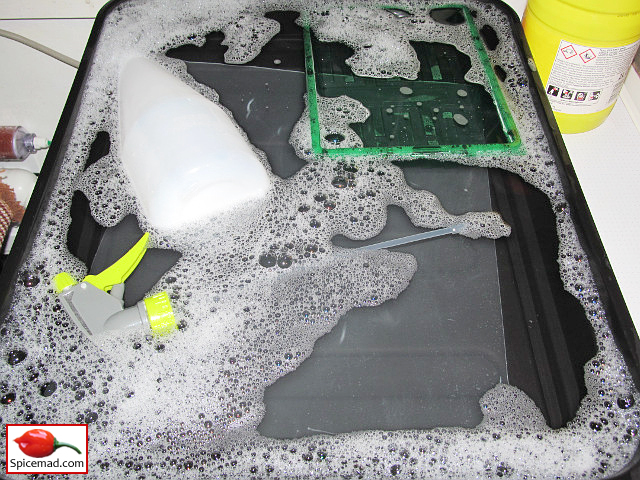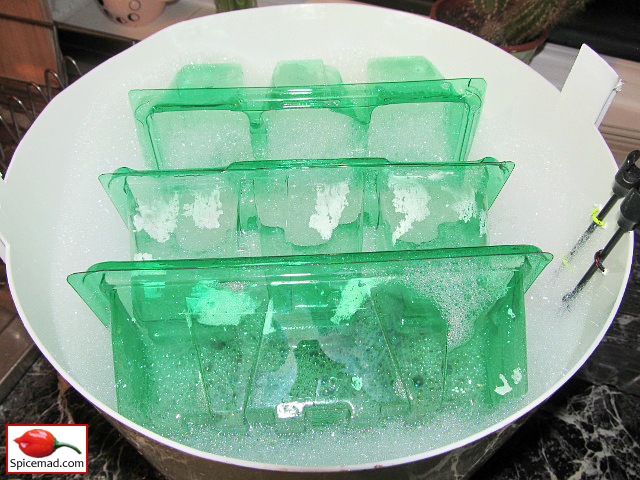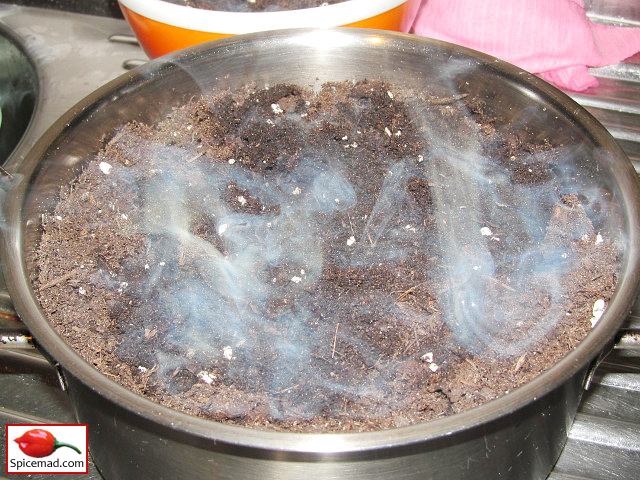The 2022 Chilli Growing Season Has Begun
The madness begins again! Yesterday evening I sowed all of this year's seeds and the 2022 chilli growing season is now officially underway. As a rule, it normally takes me an entire evening to choose which new varieties to grow, but this year it only took me about an hour. I've made a rough plan of where each variety is going to live throughout the growing season, but as with every growing season, it's not set in stone, and at some point I'll no doubt end up having to juggle the plants around. It all depends on the growth habits of the new varieties.
This season I'm growing a total of 23 varieties, 10 of which are new varieties and the rest of which are old friends that you've met before. As always, I won't be posting any photos of the new varieties until much later in the season, when I know for sure that they're true to type. Although I've grown Caribbean Red Habanero, Bangalore Torpedo and Tabasco before, this year's seeds were purchased and not saved from my own plants, so for the same reason, I won't be posting any photos of these varieties either until later in the season.
Although Carolina Reaper became the world's hottest chilli in back in 2013, I've never grown it before, so this year I decided to give it a try. As you can see, I'm also giving Caribbean Red Habanero another try this year. Caribbean Red Habanero is one of my favourite varieties, and hopefully, this year's plant will turn out to be a genuine Caribbean Red Habanero and not Antillais Caribbean like last year. Not that there's anything wrong with Antillais Caribbean, but trying to source seeds in the UK for the genuine Caribbean Red Habanero seems to have become very difficult as of late. Most of the time what should be Caribbean Red Habanero ends up being a different variety instead.
Here is a list of all the varieties that were sown yesterday evening:
Perhaps I'm being a tad ambitious by growing four Capsicum pubescens varieties. Finding space for four Rocoto plants outdoors is not a problem, but come late autumn when I move them into the glasshouse, along with the plants from the walk-in plastic greenhouse, finding space may become somewhat of an issue. This year, I only intend on growing three plants in the walk-in plastic greenhouse. Rather than placing them at the sides of the greenhouse I'm going to put them in a row down the middle instead. This should provide better airflow around the plants, and hopefully, they'll receive a bit more light too.
Rather than sowing the chilli seeds in small plastic plant pots like usual, this year I decided to use propagation trays instead. The small plant pots will still be used later on when I prick-out the seedlings, but the problem I have with my heated propagator is that most of the heat it produces is concentrated in the centre. Hardly any heat is produced around the edges, so by using propagation trays it means I can fit both trays into the centre of the propagator where most of the heat is and each of the cells gets the same amount of heat. I used to use propagation trays for germinating the seeds, but I stopped using them because I found that the compost dried out very easily. However, the cells in the trays I'm using this year are larger, so hopefully, it will no longer be an issue.
Three nights ago I gave the reverse osmosis unit a good wash down and changed the DI resin and the pre-filters. The photo below shows a side-by-side comparison of a new sediment filter and an old one that's been in use for the last six months. I'm always surprised by how much muck the sediment filter removes from the mains supply water, although it doesn't show up very well in the photo. If people start turning orange we'll know why!
Here's a short video clip, filmed on the 28th January, showing the new pre-filters being flushed to remove dust and particles from the carbon filter.
As usual, the heated propagator, spray bottle, plastic plant labels and plastic propagation trays and lids were sterilised using a mild bleach solution, and the compost was sterilised in the oven at 150C for one hour and then left to cool. I don't bother using seed starting compost for germinating chilli seeds. Sometimes I use regular multi-purpose peat-based compost, and other times I use my regular compost mixture, the same mixture that I use throughout the growing season. This year's chilli seeds have been sown in my regular compost mixture.
I normally don't bother soaking chilli seeds. Having experimented with it in the past I've never noticed any difference in germination times or rates. I know that some growers like to perform their yearly ritual of soaking chilli seeds in water, black tea or camomile tea prior to sowing, but I find that it just makes a tedious job even more tedious. Some people claim that the tannins in black tea help to soften the seed casings, and camomile tea is said to have anti-fungal properties which protect the seeds from being destroyed by any nasties. However, given that my compost has already been sterilised in the oven there's no need for me to worry about that. Some growers also soak their seeds in saltpetre (potassium nitrate) or hydrogen peroxide. Hydrogen peroxide is said to be good for reviving old seeds.
And there we have it. The chilli seeds are now in the heated propagator in the front porch and I'm using a thermostatically controlled oil heater to keep the night time temperature just above 60F, which always works fine. This time of year when the sun is out the daytime temperature in the porch usually sits around 74F. Hopefully, using the oil heater won't run too expensive now that the parasites have put the cost of electricity up. If it does then it might work out cheaper to start using grow lights again. Thankfully, the days are now slowly drawing out and spring is officially seven weeks away. All hail the Chilli Gods, and may they be kind to us this season and reward us with an abundance of lovely spicy fruits. I'll see you soon. 😁
 |
| Chilli Seeds Sown - 29th January 2022 |
This season I'm growing a total of 23 varieties, 10 of which are new varieties and the rest of which are old friends that you've met before. As always, I won't be posting any photos of the new varieties until much later in the season, when I know for sure that they're true to type. Although I've grown Caribbean Red Habanero, Bangalore Torpedo and Tabasco before, this year's seeds were purchased and not saved from my own plants, so for the same reason, I won't be posting any photos of these varieties either until later in the season.
Although Carolina Reaper became the world's hottest chilli in back in 2013, I've never grown it before, so this year I decided to give it a try. As you can see, I'm also giving Caribbean Red Habanero another try this year. Caribbean Red Habanero is one of my favourite varieties, and hopefully, this year's plant will turn out to be a genuine Caribbean Red Habanero and not Antillais Caribbean like last year. Not that there's anything wrong with Antillais Caribbean, but trying to source seeds in the UK for the genuine Caribbean Red Habanero seems to have become very difficult as of late. Most of the time what should be Caribbean Red Habanero ends up being a different variety instead.
Here is a list of all the varieties that were sown yesterday evening:
- Aji Largo
- Aji Lemon
- Bangalore Torpedo
- Cappuccino Chiltepin
- Caribbean Red Habanero
- Carolina Reaper
- Chocolate Habanero
- Costa Rican Red Rocoto
- Criolla Sella
- Cumari Pollux
- Dorset Naga
- Guampinha de Veado
- Guatemalan Orange Rocoto
- Jalapeño M
- Malawi Bird's Eye
- Orange Habanero
- Papa Joe's Scotch Bonnet
- Peruvian White Habanero
- Red Mayan Habanero
- Ring of Fire
- San Isidro Rocoto
- Tabasco
- Thai Hot Pepper
Perhaps I'm being a tad ambitious by growing four Capsicum pubescens varieties. Finding space for four Rocoto plants outdoors is not a problem, but come late autumn when I move them into the glasshouse, along with the plants from the walk-in plastic greenhouse, finding space may become somewhat of an issue. This year, I only intend on growing three plants in the walk-in plastic greenhouse. Rather than placing them at the sides of the greenhouse I'm going to put them in a row down the middle instead. This should provide better airflow around the plants, and hopefully, they'll receive a bit more light too.
Rather than sowing the chilli seeds in small plastic plant pots like usual, this year I decided to use propagation trays instead. The small plant pots will still be used later on when I prick-out the seedlings, but the problem I have with my heated propagator is that most of the heat it produces is concentrated in the centre. Hardly any heat is produced around the edges, so by using propagation trays it means I can fit both trays into the centre of the propagator where most of the heat is and each of the cells gets the same amount of heat. I used to use propagation trays for germinating the seeds, but I stopped using them because I found that the compost dried out very easily. However, the cells in the trays I'm using this year are larger, so hopefully, it will no longer be an issue.
Three nights ago I gave the reverse osmosis unit a good wash down and changed the DI resin and the pre-filters. The photo below shows a side-by-side comparison of a new sediment filter and an old one that's been in use for the last six months. I'm always surprised by how much muck the sediment filter removes from the mains supply water, although it doesn't show up very well in the photo. If people start turning orange we'll know why!
 |
| New and Old Sediment Filters - 27th January 2022 |
Here's a short video clip, filmed on the 28th January, showing the new pre-filters being flushed to remove dust and particles from the carbon filter.
As usual, the heated propagator, spray bottle, plastic plant labels and plastic propagation trays and lids were sterilised using a mild bleach solution, and the compost was sterilised in the oven at 150C for one hour and then left to cool. I don't bother using seed starting compost for germinating chilli seeds. Sometimes I use regular multi-purpose peat-based compost, and other times I use my regular compost mixture, the same mixture that I use throughout the growing season. This year's chilli seeds have been sown in my regular compost mixture.
 |
| Sterilised Heated Propagator and Spray Bottle - 29th January 2022 |
 |
| Sterilised Propagation Trays - 29th January 2022 |
 |
| Sterilised Compost - 29th January 2022 |
I normally don't bother soaking chilli seeds. Having experimented with it in the past I've never noticed any difference in germination times or rates. I know that some growers like to perform their yearly ritual of soaking chilli seeds in water, black tea or camomile tea prior to sowing, but I find that it just makes a tedious job even more tedious. Some people claim that the tannins in black tea help to soften the seed casings, and camomile tea is said to have anti-fungal properties which protect the seeds from being destroyed by any nasties. However, given that my compost has already been sterilised in the oven there's no need for me to worry about that. Some growers also soak their seeds in saltpetre (potassium nitrate) or hydrogen peroxide. Hydrogen peroxide is said to be good for reviving old seeds.
And there we have it. The chilli seeds are now in the heated propagator in the front porch and I'm using a thermostatically controlled oil heater to keep the night time temperature just above 60F, which always works fine. This time of year when the sun is out the daytime temperature in the porch usually sits around 74F. Hopefully, using the oil heater won't run too expensive now that the parasites have put the cost of electricity up. If it does then it might work out cheaper to start using grow lights again. Thankfully, the days are now slowly drawing out and spring is officially seven weeks away. All hail the Chilli Gods, and may they be kind to us this season and reward us with an abundance of lovely spicy fruits. I'll see you soon. 😁
